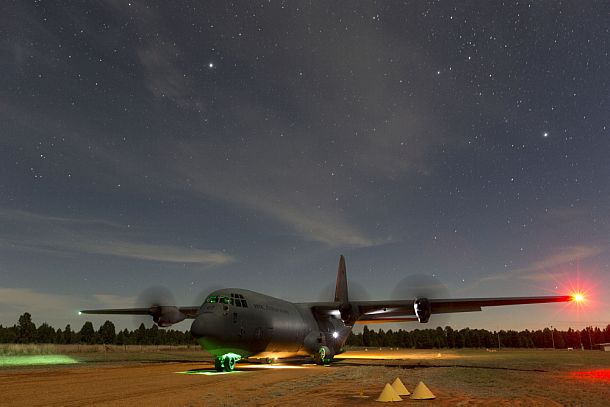In the night-time skies of rural NSW, trainee Hercules pilots and loadmasters have been flying their aircraft with the aid of Night-Vision Goggles, manuevering at low-level and landing on dirt airstrips.
From 8-17 June, No. 285 Squadron conducted an Airborne Operations Training Course from RAAF Base Richmond with pilots and loadmasters for the C-130J Hercules transport aircraft.
For these members, the course forms the culmination of six-months training to operate the Hercules, and tests their skills in operating the aircraft at low-level, formation flying, the use of night-vision equipment, and airdrop of cargo.
Once these members graduate from this course, they will be posted to No. 37 Squadron and conduct operational tasks with the Hercules, which provides Defence with a medium airlift capability, being able to carry up to 20 tonnes of cargo or more than 120 passengers, and operate from austere runways with little or no infrastructure.

A C-130J Hercules from No 37 Squadron at Gilgandra airport during No 285 Squadron's Airborne Operations Training Course. Credit: Defence
Flight Lieutenant Eleanor Bradshaw said: "For the last two weeks we've been on the tactical trainer, so it's an oportunity for us to practice the skills we've been learning for the last six months, so we've been doing just your basic flying and we've been adding in some Night Vision Goggle (NVG), Airdrop, formation and flare dispensing stuff as well".
"Flying your Herc with NVGs is very challenging, you're essentially looking through two toilet rolls and your field of vision is significanlty narrower, so you can't see left or right, up or down without moving your head and your entire world out the front has become a shade of green and black," FLTLT Bradshaw said.
Qualified Flying Instructor FLTLT Steve Andrews said the C130J's best defence was its ability to fly to fly at night unseen.
"It denies the ability of a surface-to-air shooter to visually acquire the aircraft. During the trainer we exposed our pilots to the countermeasure dispensing system which is an opportunity for them to practice live dispensing – countermeasures or flares – prior to deploying on operations in Iraq or Afghanistan," FLTLT Andrews said.
"That training is very very important because those flares or those countermeasures sytems prevent those surface-to-air infra-red heat-seeking missiles from hitting the aircraft."



